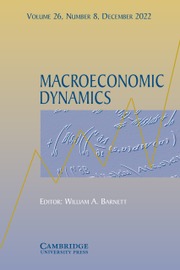Article contents
Optimal monetary policy in a two-country New Keynesian model with deep consumption habits
Published online by Cambridge University Press: 09 June 2025
Abstract
This study develops a two-country New Keynesian model incorporating deep habits in consumption to analyze macroeconomic dynamics under the optimal coordinated monetary policy. The central bank adjusts interest rates more aggressively in response to structural shocks in an open economy than in a closed economy. Deep habits strengthen the central bank’s incentive to adjust terms of trade through interest rates due to habit formation and counter-cyclical markup behavior, creating price inelasticity in demand. Deep habits also lead to deviations from the law of one price, reflected in goods-specific real exchange rates, which the degree of home bias influences. Finally, this study compares international policy coordination to noncoordination to analyze welfare gains, showing that they depend on key structural factors like price rigidity, deep habits, and home bias. Policy coordination stabilizes domestic output and inflation by internalizing externalities in terms of trade and consumption.
Information
- Type
- Articles
- Information
- Copyright
- © The Author(s), 2025. Published by Cambridge University Press
References
- 1
- Cited by

